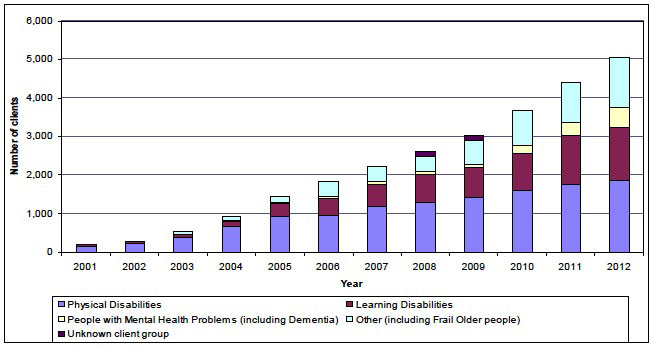Self-Directed Support (Direct Payments), Scotland, 2012
Presents the latest figures on the number of people in Scotland who use Direct Payments to purchase and manage for themselves some or all of the social care and support services they need.
1. Introduction and key points
This Statistics Release presents the latest figures on the number of people in Scotland who use Direct Payments to purchase and manage for themselves some or all of the social care and support services they need. The latest figures apply to payments made during the period 1st April 2011 to 31st March 2012.
Self-directed support (SDS)is a term that describes the ways in which individuals and families can have informed choice about how their social care and support is provided to them. SDS gives people control over an individual budget and allows them to choose how it is spent on support which meets their agreed health and social care outcomes.
SDS includes a number of options for getting support. The person’s individual budget can be:
1) Taken as a Direct Payment (a cash payment)
2) Allocated to a provider the individual chooses.The council or funder holds the budget but the person is in charge of how it is spent (this is sometimes called an individual service fund)
3) Or the council can arrange a service chosen by the individual
4) Or the individual can choose a mix of these options for different types of support
The information in this Statistics Release is derived from returns made to the Scottish Government by Scottish Local Authorities and relates only to people who take SDS as a Direct Payment (option 1 above).
Chart 1: Number of people receiving Self-directed Support (Direct Payments) packages, 2001-2012

Note: Prior to 2010, the Dementia client group was not collected separately and may have been included under ‘Mental Health Problems’ or ‘Other’.
Key findings
People receiving Self-directed Support (Direct Payments)
- The number of people in receipt of Self-directed Support (Direct Payments) has increased each year from 207 in 2001 when these figures were first collected to 5,049 in the year to 31st March 2012.
- Over the last year, the number of people in receipt of Direct Payments has increased by 15 per cent from 4,392 in 2011 to 5,049 in 2012.
- The number of people using Direct Payments to purchase care and support has increased each year while the number of people receiving home care services provided or purchased by local authorities has fallen over the last 5 years. The number of people using Direct Payments is still small when compared with the 63,500 people receiving home care services at March 2011.
- 37 per cent of people receiving Self-directed Support (Direct Payments) had a physical disability and 24 per cent had a learning disability. A further 4 per cent had both a physical and a learning disability.
Value of Self-Directed Support (Direct Payments)
- The value of direct payments has increased each year from £2.1 million in 2001 to £59.4 million in 2012.
- Over the last year, the value of direct payments increased by 18 per cent, from £50.2 million in 2011 to £59.4 million in 2012.
Contact
Email: Steven Gillespie
There is a problem
Thanks for your feedback